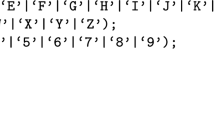Abstract
In this short paper, we present two techniques to perform residue number system (RNS) to binary conversion using diagonal function and show the relationship between the techniques for RNS to binary conversion using Chinese remainder theorem and diagonal function. We also consider RNS to binary conversion using another monotonic function due to Pirlo and Impedovo.




Similar content being viewed by others
References
L. Akushskii, V.M. Burcev, I.T. Pak, A new positional characteristic of non-positional codes and its application, in Coding Theory and Optimization of Complex Systems, ed. by V.M. Amerbaev (Nauka, Kazhakstan, 1977)
P.V. Ananda Mohan, Residue Number Systems: Algorithms and Architectures (Kluwer, Dordrecht, 2002)
P.V. Ananda Mohan, RNS to binary converter for a new three moduli set \(\{2^{n+1}-1,\,2^{n},\,2^{n}-1\}\). IEEE Trans. Circuits Syst. Part II 54, 775–779 (2007)
S. Bi, W.J. Gross, The mixed-radix Chinese remainder theorem and its applications to residue comparison. IEEE Trans. Comput. 57, 1624–1632 (2008)
N. Burgess, Scaling a RNS number using the core function. Proceedings of the 16th IEEE Symposium on Computer Arithmetic, pp. 262–269 (2003)
G. Dimauro, S. Impedevo, G. Pirlo, A new technique for fast number comparison in the Residue Number system. IEEE Trans. Comput. 42, 608–612 (1993)
G. Dimauro, S. Impedevo, G. Pirlo, A. Salzo, RNS architectures for the implementation of the diagonal function. Inf. Process. Lett. 73, 189–198 (2000)
G. Dimauro, S. Impedevo, R. Modugno, G. Pirlo, R. Stefanelli, Residue to binary conversion by the “Quotient function”. IEEE Trans. Circuits Syst. Part II 50, 488–493 (2003)
A.A. Hiasat, H.S. Abdel-Aty-Zohdy, Residue to binary arithmetic converter for the moduli set \((2^{k},\,2^{k}-1,\,2^{k-1}-1)\). IEEE Tran. Circuits Syst. Part II 45, 204–209 (1998)
P.L. Montgomery, Modular multiplication without trial division. Math. Comput. 44, 519–521 (1985)
A.R. Omondi, B. Premkumar, Residue Number Systems: Theory and Implementation (Imperial College Press, London, 2007)
G. Pirlo, D. Impedovo, A new class of monotone functions of the Residue number system. Int. J. Math. Models Methods Appl. Sci. 7, 802–809 (2013)
A.B. Premkumar, An RNS to binary converter in 2n–1, 2n, 2n+1 moduli set. IEEE Trans. Circuits Syst. Part II 39, 480–482 (1992)
M.A. Soderstrand, G.A. Jullien, W.K. Jenkins, F. Taylor (eds.), Residue Number System Arithmetic: Modern Applications in Digital signal Processing (IEEE Press, London, 1986)
N. Szabo, R. Tanaka, Residue Arithmetic and Its applications in Computer Technology (McGraw Hill, New York, 1967)
Y. Wang, Residue to binary converters based on new Chinese remainder theorems. IEEE Trans. Circuits Syst. Part II 47, 197–205 (2000)
Author information
Authors and Affiliations
Corresponding author
Rights and permissions
About this article
Cite this article
Ananda Mohan, P.V. RNS to Binary Conversion Using Diagonal Function and Pirlo and Impedovo Monotonic Function. Circuits Syst Signal Process 35, 1063–1076 (2016). https://doi.org/10.1007/s00034-015-0090-9
Received:
Revised:
Accepted:
Published:
Issue Date:
DOI: https://doi.org/10.1007/s00034-015-0090-9




